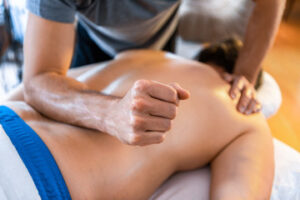Massage Therapist – What Does it Mean to Be a Massage Therapist?
Several states regulate the practice of massage therapy. Depending on the state, registration or licensure may be required to become a massage therapist.
People with the Building and Helping interests tend to be interested in a career as Massage Therapist Tulsa. Massage therapy can treat numerous conditions and ailments that are common to humans.
Stress is an unavoidable part of life, but it doesn’t have to take a toll on your mental health. Proper stress management techniques like regular exercise and massage therapy help you reduce your overall stress level and improve your mood. Massage therapists are trained to use specific techniques to ease tension, reduce anxiety and promote a feeling of wellness.
When you receive a therapeutic massage, your body releases the “relaxation response” hormones. These hormones ease muscle tension, lower heart rate and blood pressure, and increase flexibility. The positive effects of these hormones extend to your emotions as well, reducing depression and anxiety. In addition, massage can also alleviate headaches and other physical pain caused by stress.
Massage can also relieve stress and fatigue for individuals who suffer from chronic illnesses such as cancer. In one study, nurses in intensive care units who received regular massages experienced less stress and a higher quality of life than their counterparts who didn’t receive the therapy.
For athletes who participate in high-intensity activities, regular massages can reduce edema and swelling after a workout by increasing blood circulation. The relaxation response and release of endorphins from massage also enhance recovery, allowing you to return to your regular exercise routine sooner.
Therapeutic massage also lowers cortisol levels, which is produced when your body is stressed. This hormone increases glucose in the bloodstream, enhances brain activity, and curbs functions that are nonessential during a fight-or-flight response. By lowering cortisol and releasing serotonin, massage can improve your mood and reduce symptoms of depression and anxiety.
Many people report that they feel a sense of calmness and serenity after receiving a massage. It’s like an hourlong hug, which fulfills your need for human touch and comfort. It’s important to remember to drink water after your massage to prevent dehydration. Some people may feel a bit disoriented or out of it when the session is over, but that’s normal. The therapists at Compassionate Hart will be happy to provide you with some water to ensure you have an amazing experience!
Relieves Pain
A massage therapist’s job is to manually assess and manipulate the soft tissue of skin, muscle, tendons, ligaments and fascia for therapeutic purposes. It is a common and widely accepted complementary and integrative health modality to address pain and other symptoms for individuals seeking relief, particularly when conventional treatments such as drugs fail to provide complete relief or come with potential adverse effects.
While doctors and researchers are still trying to understand exactly how therapeutic massage relieves chronic pain, they do know that it has many benefits. A primary way in which it does this is by encouraging the relaxation response which reduces stress hormones that contribute to how some people subjectively experience pain. The therapist may also use techniques that specifically target the muscles and tissues that are tight and painful. This helps to loosen the tissue and promote significant pain relief, as well as increase range of motion, hand grip strength and movement efficiency.
Another way massage therapy relieves pain is by increasing the removal of waste products that build up in the muscles and joints. This occurs through the lymphatic system which is made up of tiny lymph vessels that transport lymph fluid to glands and nodes throughout the body. During a massage the lymph vessels are stimulated which increases the flow of lymph fluid and the removal of waste from the tissues.
In addition to the direct physical ways in which massage therapy relieves pain, a massage also increases the production of natural painkillers called endorphins. These are the body’s natural painkillers that help to diminish the perception of pain and create a sense of pleasure in the brain. During a massage the therapist can trigger the release of these endorphins which can provide immediate and lasting pain relief.
Integrating massage therapy into the hospital setting is an important step to improving patient outcomes and recognizing that patients have a number of complex interrelated issues that need to be addressed in order to get better. This includes pain, stress, sleep, emotions and the overall healing process.
Improves Circulation
A healthy circulatory system carries oxygen and nutrients to the cells of our body, enables us to remove waste products, supports immune function, and promotes overall vitality. Achieving optimal circulation is key to our well-being, and massage therapy plays a significant role in enhancing blood flow throughout the body.
One of the ways massage enhances circulation is by relaxing tense and constricted muscles, which helps blood move through the area freely. This, in turn, allows nutrient delivery to the muscle tissues. Furthermore, massage helps alleviate the effects of stress on the heart and blood vessels, lowering the heart rate and improving blood pressure.
In addition, the mechanical forces exerted on the soft tissue during massage trigger a process called vasodilation, where the blood vessels widen to allow more blood through (Crane, 2012). As the massage session progresses, the engorged vessel returns to its normal size, further improving circulation.
Aside from improving circulation, massage also increases the permeability of the cellular membranes, which can lead to faster healing and reduce swelling in soft tissue (Jones, 2006). The improved permeability of cells also allows for the elimination of harmful substances, such as toxins or excess fluids, from the body.
Another way massage improves circulation is by reducing the amount of waste materials stored in muscles, which promotes the release and removal of those substances through the lymphatic system. This, in turn, reduces the load on the muscles and joints, thereby allowing for more efficient functioning.
Massage is also known to stimulate the movement of fatty acids through the bloodstream, which can further aid in the removal of toxins and fluids.
Massage is a natural and effective way to enhance circulation, which is why it is so beneficial for athletes who require regular exercise and recovery to keep their performance at its peak. However, it is important that individuals communicate with their massage therapist regarding any pre-existing health conditions or areas of discomfort to ensure appropriate techniques are used to avoid injury and risky complications. In the long run, it is hoped that more individuals will adopt massage as an essential part of their wellness routine to help them achieve and maintain a healthier lifestyle.
Enhances Sleep
Getting a good night’s sleep is important for overall health and well-being. Insomnia and sleep disturbances can lead to a variety of issues from physical ailments to mental problems like stress, anxiety, depression and more. As a result, it is crucial to find ways to improve sleep habits and enhance restorative sleep.
Fortunately, massage therapy is an effective and natural way to do just that. As a whole body approach, massage helps relax the muscles and calm the mind, creating a perfect environment for a healthy sleep pattern.
The increased blood flow resulting from massage also supports a more structured sleep pattern. The calming effects of massage help with mood and can alleviate symptoms of anxiety, depression, and stress. This leads to improved sleep and can reduce the risk of chronic diseases, which in turn may improve your overall quality of life.
Studies have shown that massage therapy increases serotonin, a neurotransmitter and precursor to the sleep-wake hormone melatonin. Serotonin influences brain communication through areas called the raphe nuclei, helping regulate your body’s circadian rhythms and sleep-wake cycles. While science has not yet discovered the exact mechanism by which this happens, it is clear that massage can significantly contribute to better sleep patterns.
Those who have been dealing with persistent insomnia or other sleep-related disorders may see the biggest benefit from regular massage. For these individuals, it is recommended to schedule appointments throughout the week in order to experience consistent and optimal results. This can help ease sleepless nights and ensure that you are well-rested and ready to take on the day. Moreover, incorporating self-massage at home with the use of simple tools can further aid in improving your sleep by promoting relaxation and reducing tension. This will allow you to drift into a more restful and deep sleep cycle.






